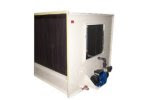Hi Outsourced Article: Hi Article of The Month!
Hi Commissioning HVAC systems thoroughly:
By examining all aspects of the HVAC system and its components—from design through commissioning—the system will run more efficiently and effectively.
HVAC systems and temperature control strategies have been getting increasingly complex and difficult to implement. Verification has also become more complex. System design engineers, new ASHRAE control strategies, U.S. Green Building Council LEED requirements, and building construction codes (including International Building Code and state codes) have put increasing demands on getting systems to operate at peak efficiency.
Custom applications and control sequences have challenged today’s installation and temperature control contractors. The use of “canned” control software has its limitations in achieving the specified control sequences. Custom programming for a particular project may not be possible when using the “economical” control software, as compared to the full BAS version of direct digital control (DDC) software.
So what is expected of the commissioning (Cx) professional? Early discovery and disclosure of the issue, a thorough design assessment during the construction document review stage, and a thorough review of the temperature control shop drawing.
Cx professionals are pushed to the limit to develop functional performance tests that demonstrate the intent of the specified control sequences. Every possible situation or scenario must be considered. For example, what happens to the system when operating on generator power, and will the control system reboot to allow programming to revert to normal operation after restoring to normal power? Will fans rotate in the proper direction when on generator power? These situations can and do occur, and it’s up to the Cx professional to demonstrate and document repeatable and acceptable outcomes for each condition per the design intent.
ASHRAE,
Building Commissioning Assn.,
AABC Commissioning Group (ACG), and other organizations have Cx guidelines with elaborate flowcharts for the process; however, these cannot be treated as a one-size-fits-all solution. Commissioning agents, or CxA, should ask: What happens when an initial functional test is accepted, but it fails during a repeat test or an integrated systems test? What adjustments need to be made to the Cx process or to the system functional test? Basically, thought must be applied to each situation and a team approach taken. A “canned” approach will not suffice as each situation is different.
Use of O&M manuals:
More information is provided in the manufacturer’s operations and maintenance (O&M) manuals on proper component and system installation, operations, and maintenance. Design engineers typically work with sales application engineers for equipment selections, but are not always made aware of all the specific system installation details. Engineers should pay close attention to the manufacturer’s information, and provide detailed specifications so that a system is designed as intended For example, manufacturer-designed temperature settings may cause an engineer to choose one HVAC product over another. The same manufacturer may have several options on boiler venting materials, depending on the application and system design intent. PVC venting may be appropriate for lower heating system hot water temperatures. However, due to the way the boiler is controlled, higher temperatures may be experienced. Thus, the PVC venting would not be appropriate.
Programming equipment electronics is required on most mechanical equipment. Equipment vendors say they “commission” their equipment, but in actuality they are just doing a standard start-up and check routine, and setting the programming to some standard setting that may or may not be applicable to the particular project at hand. Cx professionals need to be involved with the factory start-up technician to verify proper settings are used for the particular project, and not just use the factory program defaults. Too often factory default settings are left in place and are misapplied. Along with this, the design professional needs to identify which trade is responsible for providing the interface card from the equipment manufacturer’s equipment to the BAS for proper system and monitoring purposes.
Many times the project specification sequences of operation do not spell out all the possible details required for programming the equipment. For example, on a computer room air conditioning (CRAC) unit, at what point should a system high-humidity alarm be generated—when it’s ±5% RH, or ±10% RH from setpoint? Should the alarm be audible, or communicated to the BAS, terminal screen, or both? What temperature tolerance from setpoint should be allowed before generating an alarm? Should a temperature or humidity deadband be applied? Do the settings meet the design intent?
Another important aspect of O&M manuals is that more and more equipment manufacturers want to control—or have taken more active control over—the temperature controls for the HVAC system. Traditionally, the temperature control contractor would take on the responsibility of integrating control of all equipment into the BAS. Equipment manufacturers want or demand that they take control of the building systems related to their particular unit.
For example, a high-efficiency boiler manufacturer may have an integral factory-mounted and wired circulating pump, sometimes up to three pumps. The boiler manufacturer determines when its pump needs to operate and at what speed, versus the temperature control contractor setting up the control requirements. The temperature control contractor ends up just enabling the system to operate. Temperature setpoints are programmed into the equipment manufacturer’s controls.
Some boiler manufacturers have integral variable speed pumps that are controlled from an external sensor or other device. The hot water heating system distribution design must accommodate or be suitable for the boiler manufacturer application. System bypass flow may be required and the rate of bypass verified. All too often, this information is not supplied during shop drawing review, or in the case of a product substitution, specifics as to the boiler control design are not disclosed. Though more equipment manufacturers are incorporating their own controllers, there’s always the opportunity to specify which control setpoints, commands, and alarms can be controlled or monitored by the BAS. Again, it’s important to have an interface card between equipment controls and the BAS.
Manufacturers also have tried to make O&M manuals apply to several or all lines of product offerings, making the manuals extremely long. The reviewer of the O&M manuals must be careful in applying the right information to the particular model furnished on that particular project. In today’s age of offering customization of products, some manufacturers have the ability to customize the O&M manuals to the specific project; however, they may be reluctant to do so as this takes additional time. Many project specifications do not include language to require electronic O&Ms or a searchable PDF file to filter out non applicable items. Also during the owner training, discussions should focus on O&M manual aspects for that project, so as to enhance the training experience for the maintenance staff.
The Cx professional should review the O&M manuals at the earliest stage in the construction process to help avoid issues later in the construction process. Ideally, the contractor should make the O&M manuals available to the Cx professional and the design engineer as soon as the equipment shop drawings are approved.
Owner engagement:
Many times, building O&M staff are not hired until the building construction project is completed and the building is fully occupied. This provides a challenge to the contractor during O&M training to demonstrate all aspects of the systems.
Where construction projects involve an addition to an existing building or a new building on a campus, it can be very beneficial to involve the maintenance staff during early stages of the project. Various walkthroughs by the O&M staff give them better familiarity with the building components and construction before issues are covered up or buried. The walk-throughs give them a chance to document (with photos) the buried or concealed items. Involvement by the staff during functional testing can provide a better understanding of the system design parameters and normal operation settings. This early engagement by the O&M team can also provide smoother and better-understood training sessions.
Some architecture and engineering firms and some contractors may argue that early maintenance involvement results in numerous design changes and costly change orders. Maintenance staff are sometimes reluctant to provide their input during the development of the owner’s project requirements and basis of design documents early in the project. They usually provide general input in these documents and rely on others to see that their wishes are implemented.
Repeatability of results:
During functional testing, the Cx team makes temporary adjustments to simulate conditions to test system operation and control sequences. Sometimes repeatability of test results is not consistent when the same test is performed again at a later date. How should this be handled? How can the owner be assured that the system is operating as intended when getting different results?
For example, during a functional test a satisfactory test result is observed for an electronic-type airflow measuring station in determining system minimum air volume. The air volume is what’s called for in the project specifications and the airflow station calibration is verified. Thus one can assume all is fine. However, during another test of the system at a later date, erroneous readings are observed for the airflow station. The Cx professional should facilitate the troubleshooting effort to determine what caused the anomaly. The root cause must be determined and corrected, and the functional testing/calibration of the airflow station must be repeated—don’t just treat the symptom. Documentation of the test procedure and data is critical. Sensor or other device failures can and will occur after the initial test.
ASHRAE,
PECI,
ACG, and other Cx organizations provide guidance on a procedural or a step-by-step process in determining functional testing compliance to the design intent. The expectation is that, given the same conditions, the same results are achieved. Experience in dealing with these complex HVAC systems may have other results on another day, with different outdoor temperature conditions and other equipment idiosyncrasies.
Isolation of the problem:
Sometimes the solution to a problem is not apparent at first glance. For example, a building is experiencing periodic pressurization problems causing building exterior doors to hold open. This can be a huge problem when security is a major design aspect of the facility. The Cx professional checks with the design engineer on equipment sizing and the design intent. The testing and balancing (TAB) agency (contractor’s) report appears fine when operating at design conditions. However, under certain conditions the building experiences excessive positive pressure issues.
During a troubleshooting session with the control contractor, an odd or inconsistent signal from a mixed air sensor is discovered. The importance of the faulty sensor affected many of the system components in the BAS. When the problem sensor was isolated, the solution was apparent. However, to get to the root cause of the problem, many other variables were viewed at the same point in time and compared to each other.
In another example, temperature setpoint cannot be maintained in a particular area of the building. Temperatures and airflows are reviewed, and BAS system parameters are reviewed. During the review process, it’s discovered that some similarities exist with several variable air volume (VAV) air terminal boxes; in particular the VAV discharge air temperature is too low. The VAV hot water reheat coil control valves are commanded full open and still there is no change in discharge temperature. Tracking down all valving in the hot water piping distribution system reveals that a manual shut-off valve was fully closed, due to maintenance activities performed previously.
Importance of trend logs:
The importance of trend logs cannot be stressed enough in Cx. Analyzing the data is a key component in verifying proper system response and proper system operation. However, analyzing only one set of data without getting the entire picture of the system can lead to the wrong conclusions.

In a situation where no DDC BAS exists, Cx professionals must rely on other means, including data loggers or other devices to trend temperatures, pressures, flows, and humidity levels. Data loggers (depending on the particular model) can provide a substantial amount of trend data, but the CxA must be cognizant of where the logger was placed and under what condition the particular HVAC system was operating. The data loggers do not provide the entire picture of the HVAC system at any point in time, such as the position of system control dampers during certain times of the day. Where DDC systems are installed, data loggers can be used as a tool to provide an independent means of comparing temperatures versus what the BAS indicates. Many times the Cx professional discovers that the wrong control point has been mapped to the graphic on the BAS.
For security reasons, some BAS will not allow remote access or allow only limited data retrieval with regard to trend logs after building occupancy has started. What choices does the CxA have to document the proper system operation? How can the Cx professional access trend logs? The options may be limited or very restrictive. Completing the Cx process well before owner occupancy would be the best option. However, the reality is that very seldom are all issues resolved before owner occupancy. Cx professionals may be required to be on-site and in the presence of an authorized owner representative at all times during this data retrieval process. The old-fashioned data collection manual method could be used but would be very time consuming. Another option that might be available, pending owner approval, is to specify what trending data the Cx professional wants to review, then have the owner do the trending and forward the trends to the Cx professional for analysis. However, documenting the system operation still remains an important task.
*Edward Hurtz, PE, LEED AP, CxA, GRAEF, Milwaukee
10/12/2012
*Edward Hurtz is a project manager at GRAEF, where he has been responsible for mechanical engineering for HVAC systems for commercial, industrial, higher education, and healthcare facilities for more than 30 years. His Cx experience is primarily related to LEED Cx projects over the past seven years.






.jpg)
.jpg)
.jpg)
.jpg)






.jpg)





